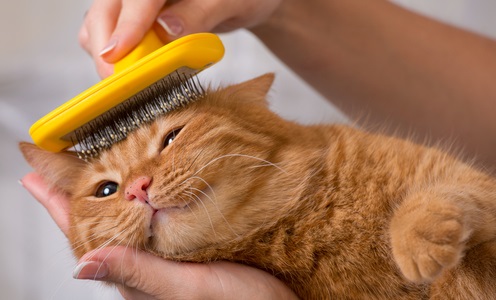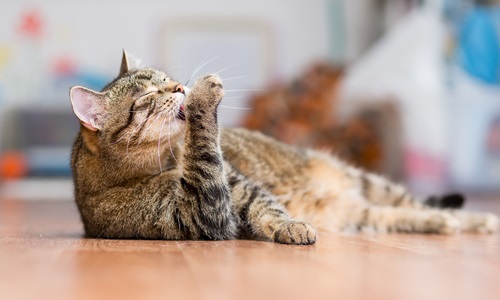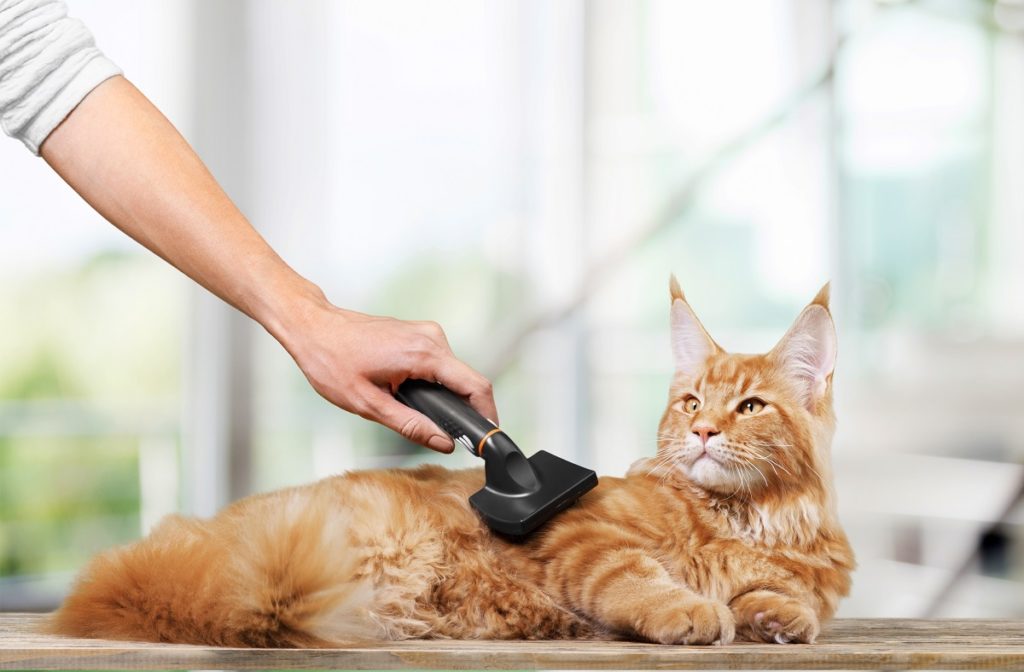There are few rites-of-passage that veteran cat owners know better than “the sound” – the measured, increasingly-loud noises of a cat coughing up a hairball in the middle of the night can wake even the soundest sleeper. Barely awake, it’s usually immediately followed by a pet parent’s rush into a usually futile effort to spare their carpet from a wet clump of coughed-up fur. For many folks, the question remains: why do cats indulge in this admittedly stomach-turning feline ritual?
It may come as a surprise to learn that this irritating behavior is a perfectly normal, healthy mechanism for a cat to shed his excess hair after grooming. As much as he may make loud noises and dramatic back-hunching movements as he’s coughing, it’s a straightforward affair that, inevitably, helps him feel better. The first step to reducing these unsightly “gifts” and limiting their appearance is understanding why cats develop hairballs.
Feline Hairball Facts: Kitties Can’t Help It
While some cats may seem to plot certain mischievous behaviors – such as pushing his human’s belongings off a table edge, for instance – hairballs are not premeditated. He genuinely can’t help his hairballs any more than a person can avoid the urge to clear his or her throat when feeling congested. For anyone who’s ever cleaned out a hairbrush or looked down at the sink after shaving, it’s not strange to note quite a bit of hair or stubble left behind. Cats don’t have the benefit of grooming tools, and instead must rely upon their tongues and paws to keep their coat sleek, shiny, and free of debris.
A cat feels a natural instinct to groom himself, whether it’s habitually, in an attempt to get debris out of his fur, or after a meal to clean up. It’s as normal to him as brushing one’s hair or teeth would be to his human counterparts, and hairballs are simply a way of life for him. In fact, watch his behavior directly after coughing up a hairball – he’ll likely seem perfectly fine, and might even act more energetic. He may even take off at a breakneck pace to zoom around the house – this is a latent instinctual behavior thought to separate a cat from biological evidence of his presence, thus keeping him safe from predator discovery. Incidentally, this same reasoning explains the occasional speed-racing through the halls immediately after he has used the litterbox.
Cat Got Your Tongue?
Cats of all sizes, lions included, groom one another to establish bonding and friendship within their chosen family, or pride. That means that your cat has likely licked your hand or arm at some point while cuddling in your lap, or greeting you after a long day. Anyone who’s owned or interacted with a cat has probably noticed how rough his tongue feels, particularly if he was insistent about the grooming. This sandpaper-like phenomena comes courtesy of small barbs on his tongue, called papillae, which face backwards in his mouth, towards the throat. In the wild, these hooks help remove meat from bones during feeding, and act as a sort of built-in comb for brushing fur clean. They’re extremely efficient, but in housecats, they can be a considerable disadvantage, particularly in long-haired breeds.
 That’s because those hook-like papillae face backwards, and once a thread, hair, or other particle is taken into the mouth by licking, it’s very difficult or impossible for the cat to remove it. This is one of the primary reasons that vets recommend keeping thread-like objects like Christmas tinsel, string, ribbon, or yarn away from cats: they’re unable to “spit it out” if it gets caught in their papillae, and this can lead to choking or ingestion. A cat’s individual hairs can only grow so long or wide, but a length of nylon string doesn’t have those limitations. It can’t be digested, and will become dangerously tangled inside a cat’s intestines, necessitating surgical removal.
That’s because those hook-like papillae face backwards, and once a thread, hair, or other particle is taken into the mouth by licking, it’s very difficult or impossible for the cat to remove it. This is one of the primary reasons that vets recommend keeping thread-like objects like Christmas tinsel, string, ribbon, or yarn away from cats: they’re unable to “spit it out” if it gets caught in their papillae, and this can lead to choking or ingestion. A cat’s individual hairs can only grow so long or wide, but a length of nylon string doesn’t have those limitations. It can’t be digested, and will become dangerously tangled inside a cat’s intestines, necessitating surgical removal.
Why Do Cats Groom Themselves?
Cats groom for an almost endless list of reasons, such as:
- Building companionship within their pride
- Keeping their coat sleek and aerodynamic for hunting
- Regulating body temperature by removing insulating dead fur
- Removing dirt and debris that may irritate their skin or pull at fur
- Dislodging parasites such as fleas, flea dirt, ticks, and mites
- Self-soothing and stress relief
Even if pet parents take the time to groom their cat with an external tool (such as a mitt or rubber-noduled pet brush), they’ll still naturally groom themselves. It’s a habit that’s ingrained in their genetics as much as chasing bugs and mice, as well as a way to demonstrate their emotions. Depending on a cat’s temperament, owners may have seen him:
- Lazily groom a paw as he’s relaxing on the couch (“I’m feeling good and unthreatened in this environment, so I can take the time to groom”)
- Angrily groom his body where a person has touched him (“I did not want you to touch me right now and I’m going to wash your scent right off of my body to show my contempt”)
Feline folks may have also noticed their pet excitedly lick at the air, the couch, their arm, or anything in reach when his back is scratched just above the tail. This is actually an intriguing nerve cluster-behavior connection some cat behaviorists call the “lick spot.” While it’s not yet completely understood, it’s thought to be a leftover instinctual reaction from kittenhood. This back spot is a place where a mother cat would lick and groom while her kittens were feeding to encourage them to eat – hence the frantic licking.
Should I Stop My Cat From Grooming?
In general, grooming is an excellent indicator for overall health in your cat. As long as a cat’s coat is sleek and shiny, it means he feels well enough to groom himself regularly. In fact, vets typically recommend that cat owners bring their feline friends in immediately if their coats begin to look uncharacteristically dull, patchy, or overgrown. It’s one of the most visible symptoms of illness or stress in a cat, and catching it early can mean better treatment success for whatever’s ailing them.
The only two times pet parents should keep a cat from grooming himself are during excessive stress or parasite-related grooming (such as bald, short patches in his fur where the skin shows through), or if he has something on his fur he can’t ingest safely. Topical flea medications are a very popular treatment among cat owners, who are equally familiar with the unusual application site. Typically, directions state to apply the medication between the shoulder blades – that’s because it’s the one place a cat can’t reach to groom himself. For households with more than one cat, be aware that cats need to be isolated, at least temporarily, when topical medication is used: otherwise, they may groom it off of each other and become ill.
Where Do Cat Hairballs Come From?
All that grooming, combined with the papillae’s extraordinary ability to hang onto individual strands of fur, means a cat swallows a great deal of his own fur. Think about this fur in terms of a bathtub drain for a moment: sometimes, strands of hair simply slide down the drain and into the sewer, but sometimes a mat or clog of hair snarls in the drain instead.
 Because hair is pure protein and can’t be dissolved by a cat’s stomach acid, any fur that doesn’t naturally pass through his digestive system becomes a real problem. That hair causes indigestion, and takes up valuable real estate where food nutrients could fit, which could have meant a life-or-death food scenario to his wild feline ancestors. And so – up it comes, along with stomach acid, bile, partially-digested food, and other terrible things to step in at 3am in the morning.
Because hair is pure protein and can’t be dissolved by a cat’s stomach acid, any fur that doesn’t naturally pass through his digestive system becomes a real problem. That hair causes indigestion, and takes up valuable real estate where food nutrients could fit, which could have meant a life-or-death food scenario to his wild feline ancestors. And so – up it comes, along with stomach acid, bile, partially-digested food, and other terrible things to step in at 3am in the morning.
As the descendent of a much larger predator that needed to eliminate previously-eaten prey meals for parasites, spoil, and other health concerns, this vomiting doesn’t phase a cat very much. It’s business as usual for him, even if it’s a particularly bad and/or nauseating start to his human’s day.
Do Hairballs Mean My Cat Is Sick?
Hairballs are natural and generally nothing to worry about. However, for owners who notice their cat’s hairballs have a red or pink tinge, contain foreign bodies like small toys or ribbon, or seem excessively foamy, their pet will need a checkup. Your cat will also need a checkup in the rare case that he has a feline hairball impaction. There may be perfectly innocent explanations for the cat’s concerning hairballs, but it’s better to talk to a vet than risk harm through ignoring the issue.
While it’s not the most exciting part of cat ownership, snapping a camera phone picture or two of a cat’s worrisome hairball (for those who can stomach it) can greatly aid the vet in diagnosis. Depending on the local vet’s office and the way they interact with patient emails and other forms of digital communication, pet parents might not even need to bring a cat in for an examination.
How Do I Stop My Cat From Having Hairballs?
There is no “magic cure” for hairballs, per se, but there are a few ways fur pet parents can save their carpet from constant assault by feline gastric projectiles. The first step is reducing the amount of overall stray hair on one’s cat. By removing his dead fur and debris before he needs to, it won’t end up in his stomach to make a hairball. There are several easy steps you can take to make this happen:
- Brush him: Not every cat is thrilled about this tactic, so its success will depend largely on the individual cat’s attitude towards his human’s grooming skills. Use a rubber-bristled brush and a gentle hand, and always stroke with the cat’s fur, not against it. Periodically remove the fur from the brush, and pause or stop if he starts lashing his tail or displaying other signs of irritation.
- Vacuum furniture and carpets frequently: Just because a cat has shed the fur from his body doesn’t mean it’s necessarily gone for good. Soft areas like a favorite couch cushion, a cat tree perch, or a soft pet bed are notorious for accumulating fur. This stray fur ends up getting tangled back in a cat’s still-attached fur, and ingested during grooming anyway. Experts recommend using a fur-targeting vacuum attachment to whisk fur off of these frequented surfaces – it not only aids in the removal of pet hair and dander from the home, but helps cats avoid hairballs.
- Give him opportunities to remove shedding hair through play and exploration: Many cat toys, trees, and towers now incorporate brush-like panels and arches that allow cats to rub their cheek and side against them. There are also innovative “corner” accessories that offer the same brushing surfaces in 90-degree angle attachments that bolt to wall corners or furniture to encourage the behavior. This tactic is similar to brushing, except the cat decides when and where to use it – making it more likely to be used. (Some smart cat owners recommend rubbing fresh catnip on these accessories to encourage feline curiosity and use.)
- Get him professionally groomed: While bathing can be off-putting and even outright traumatic to a normally self-grooming cat, certain long-haired breeds can still benefit from a trip to the groomers. For owners of Persian, Maine Coon or other similar long-haired breeds, it’s worth exploring local options for cat grooming. These individuals are trained in handling cats as well as dogs, and can take certain sanitary measures – such as trimming back fur below the tail – to prevent bathroom-related messes as well as ensure proper grooming techniques.
 For pet owners who have removed stray fur from their cat’s environment but still find themselves staring down unexpectedly at puddles of furry foam, a dietary additive may be the key. An over-the-counter hairball paste, easily found in most pet stores, can help lubricate his digestive tract to pass fur naturally. In the event that this still doesn’t make a dent in his hairball habits, it’s important to speak to his vet about potential treatments, supplements or diet-adjustment solutions.
For pet owners who have removed stray fur from their cat’s environment but still find themselves staring down unexpectedly at puddles of furry foam, a dietary additive may be the key. An over-the-counter hairball paste, easily found in most pet stores, can help lubricate his digestive tract to pass fur naturally. In the event that this still doesn’t make a dent in his hairball habits, it’s important to speak to his vet about potential treatments, supplements or diet-adjustment solutions.
Summary: Keeping Your Cat’s Hairballs In Check
While the occasional hairball will always be part and parcel of cat ownership, knowing why a cat produces them (and how to reduce them) can protect both an owner’s sanity and their carpet. For pet parents looking to keep their sanity, their homes clean, and of course, their cat happy and healthy, invest in a quality cat brush, a good vacuum attachment, and a little patience, and it might just help to prevent being woken by the dreaded “sound” again – well, at least not as often!
Sources:
- “What to Do About Hairballs in Cats.” Pets.WebMD.com, (no publish date), https://pets.webmd.com/cats/guide/what-to-do-about-hairballs-in-cats#1. Accessed June 23, 2019.
- “Cat Watch | A Hairy Dilemma.” Vet.Cornell.edu (Cornell University College of Veterinary Medicine), (no publish date), https://www.vet.cornell.edu/departments-centers-and-institutes/cornell-feline-health-center/health-information/feline-health-topics/hairy-dilemma. Accessed June 23, 2019.
- Paul, Dr. Mike, DVM. “What Causes a Feline Hairball?” Pet Health Network.com, April 4, 2015, http://www.pethealthnetwork.com/cat-health/cat-diseases-conditions-a-z/what-causes-a-feline-hairball. Accessed June 23, 2019.




